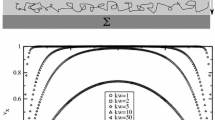Abstract
We use molecular dynamics simulations in order to investigate the time evolution of the effect of adsorbed polymer coatings on the electro-osmotic flow (EOF) in a capillary. Weakly adsorbed coatings show no time-dependent performance, but they do not strongly reduce the EOF. On the other hand, strongly adsorbed coatings made of longer polymer chains are often quenched in non-equilibrium conformations that can strongly reduce the EOF over extremely long periods of time. For intermediate adsorption strengths, we observe that the EOF increases as a function of time due to the relaxation of the coating layer. The concentration of polymers in solution and the length of the polymer chains also affect the time-dependence of the EOF. These results show that the quality of electrophoretic separations can depend on the waiting time between the formation of the coating and the beginning of the separation. We conclude by suggesting experimental tests of our predictions.





Similar content being viewed by others
References
Cao Q, Zuo C, Li L, Ma Y, Li N (2010) Electroosmotic flow in a nanofluidic channel coated with neutral polymers. Microfluid Nanofluid 9:1051–1062
Cao Q, Zuo C, Li L, Yang Y, Li N (2011) Controlling electroosmotic flow by polymer coating: a dissipative particle dynamics study. Microfluid Nanofluid 10:977–990
Chiari M, Cretich M, Damin F, Ceriotti L, Consonni R (2000) New adsorbed coatings for capillary electrophoresis. Electrophoresis 21(5):909–916
Doherty EAS, Berglund KD, Buchholz BA, Kourkine IV, Przybycien TM, Tilton RD, Barron AE (2000) Critical factors for high-performance physically adsorbed dynamic polymeric wall coatings for capillary electrophoresis of DNA. Electrophoresis 23(16):2766–2776
Harden JL, Long D, Ajdari A (2001) Influence of end-grafted polyelectrolytes on electro-osmosis along charged surfaces. Langmuir 17(3):705–715
van Heiningen JA, Hill RJ (2011) Polymer adsorption onto a micro-sphere from optical tweezers electrophoresis. Lab Chip 11(1):152–162
Hickey OA, Harden JL, Slater GW (2009) Molecular dynamics simulations of optimal dynamic uncharged polymer coatings for quenching electro-osmotic flow. Phys Rev Lett 102(10):108304. doi:10.1103/PhysRevLett.102.108304
Hickey OA, Holm C, Harden JL, Slater GW (2011) Influence of charged polymer coatings on electro-osmotic flow: molecular dynamics simulations. Macromolecules 44(23):9455–9463
Horvath J, Dolník V (2001) Polymer wall coatings for capillary electrophoresis. Electrophoresis 22(4):644–655
MacDonald AM, Bahnasy MF, Lucy CA (2011) A modified supported bilayer/diblock polymer working towards a tunable coating for capillary electrophoresis. J Chromatogr A 1218(1):178–184
de Pablo JJ (2011) Coarse-grained simulations of macromolecules: from DNA to nanocomposites. Ann Rev Phys Chem 62(1):555–574
Qiao R (2006) Control of electroosmotic flow by polymer coating: effects of the electrical double layer. Langmuir 22(16):7096–7100
Qiao R, He P (2007) Modulation of electroosmotic flow by neutral polymers. Langmuir 23(10):5810–5816
Shendruk TN, Hickey OA, Slater G, Harden JL (2011) Electrophoresis: when hydrodynamics matter. Curr Opin Colloid Interface Sci. doi:10.1016/j.cocis.2011.08.002
Slater GW, Holm C, Chubynsky MV, de Haan HW, Dube A, Grass K, Hickey OA, Kingsburry C, Sean D, Shendruk TN, Zhan L (2009) Modeling the separation of macromolecules: a review of current computer simulation methods. Electrophoresis 30(5):792–818
Soddemann T, Dünweg B, Kremer K (2001) A generic computer model for amphiphilic systems. Eur Phys J E 6(5):409–419
Soddemann T, Dünweg B, Kremer K (2003) Dissipative particle dynamics: A useful thermostat for equilibrium and nonequilibrium molecular dynamics simulations. Phys Rev E 68(4):46,702
Tessier F, Slater GW (2005) Control and quenching of electroosmotic flow with end-grafted polymer chains. Macromolecules 38(16):6752–6754
Tessier F, Slater GW (2006) Modulation of electroosmotic flow strength with end-grafted polymer chains. Macromolecules 39(3):1250–1260
Wang Y, Dubin PL (1999) Capillary modification by noncovalent polycation adsorption: effects of polymer molecular weight and adsorption ionic strength. Anal Chem 71(16):3463–3468
Acknowledgments
We would like to thank Christian Holm for helpful discussion. This work was supported by the National Science and Engineering Research Council through Discovery Grants to GWS and JLH. OAH would also like to acknowledge funding from a University of Ottawa Entrance Scholarship and National Science and Engineering Research Council through the Canada Graduate Scholarship program. Sharcnet provided computational resources for this work.
Author information
Authors and Affiliations
Corresponding author
Rights and permissions
About this article
Cite this article
Hickey, O.A., Harden, J.L. & Slater, G.W. Computer simulations of time-dependent suppression of EOF by polymer coatings. Microfluid Nanofluid 13, 91–97 (2012). https://doi.org/10.1007/s10404-012-0944-4
Received:
Accepted:
Published:
Issue Date:
DOI: https://doi.org/10.1007/s10404-012-0944-4




